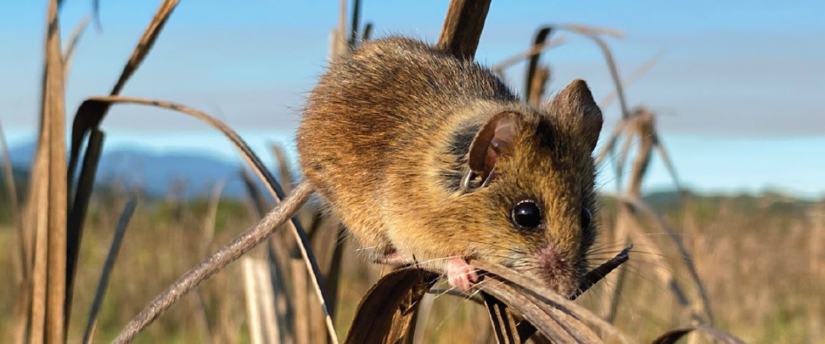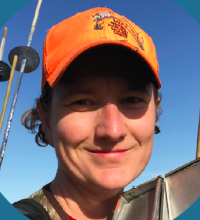
Delta Science Fellowship 2020
Fellow: Katherine Smith, Postdoctoral Scholar, UC Davis
Research mentor: Douglas Kelt, University of California, Davis
Community mentors: Laureen Barthman-Thompson, California Department of Fish and Wildlife
Why this research matters
The salt marsh harvest mouse is an endangered species that makes its home in the marshes of the San Francisco Bay Delta. It is primarily threatened by habitat loss, and millions are spent performing tidal restoration every year, with little data on how the species responds to restoration or utilizes the novel microhabitat features. Further, very little research has been done to date on how climate change, including associated sea-level rise, will affect the mouse. Without this data, we are making changes to habitat with the intention of benefitting the species, without any evidence that our actions will have a positive impact.
Project
This study aimed to investigate the response of the salt marsh harvest mouse to several threats of climate change, including extreme annual climate cycles and sea level rise. The study was based on ongoing population surveys in the Suisun Marsh, and a study of upland/elevated refuge throughout the species’ range, over the two-year study. It also involved the piloting of advance remote detection technology (camera traps, audio detectors, and digital mouse traps) and effective, affordable high tide refuge (islands and trellises). Finally, ongoing trapping efforts at established survey sites is providing data for ongoing analysis on the effects of weather patterns and space needs of populations.
Results
The preliminary results of this study have completely changed the perspectives of salt marsh harvest mouse experts with regard to high tide refuge. While Dr. Smith set out to measure how far into uplands mice ventured during king tide events, she was surprised to see that there was no mass exodus of mice into the uplands and that they remained largely on the marsh plane, away from levees and uplands, especially during year one of the study which followed a very wet winter. This seems to be largely driven by competitive interactions, as more aggressive rodents were often abundant in the upland areas, and predators were rare overall. These observations led Dr. Smith to develop several side projects, including the trellis study, to determine how to create elevated refuges, resistant to colonization by more aggressive upland competitors. They also indicate that it is important consider the entire small mammal population when making recovery decisions.
Management Applications
This project has provided resource managers with a more complete understanding of the factors limiting the recovery of the endangered salt marsh harvest mouse. In order to recover this species, researchers and managers need to move away from studies that consider the mouse in isolation, and instead consider the entire community that this endangered species lives in. We must also stop relying on assumptions that if we create habitat features, they will available and effective for the mouse. Recovery actions must be based on methods that have been proven effective. Initial results of the study have been communicated informally to the US Fish and Wildlife Service, California Department of Fish and Wildlife, US Geological Survey, East Bay Regional Parks, the Suisun Resource Conservation District and other entities. It was also presented, in part, at regional and national conferences. The US Fish and Wildlife Service has also considered preliminary results of this study in preparation of permits and recovery documents, such as the upcoming 5 Year Review.
Select Publications and Presentations
Smith KR, Kelt DA. 2019. Waterfowl management and diet of the salt marsh harvest mouse. Journal of Wildlife Management, 83(8):1687–99. https://wildlife.onlinelibrary.wiley.com/doi/abs/10.1002/jwmg.2175
Smith KR, Barthman-Thompson L, Estrella SK, Riley MK, Trombley SN, Rose C, and Kelt, DA. 2019. Demography of the salt marsh harvest mouse (Reithrodontomys raviventris halicoetes) and associated rodents in tidal and managed wetlands. Journal of Mammalogy, 100(6):1–16. https://doi.org/10.1093/jmammal/gyz183
Smith KR, Riley MK, Barthman–Thompson L, Statham MJ, Estrella S, Kelt Da. 2018. Towards Salt Marsh Harvest Mouse Recovery: Research Priorities. San Francisco Estuary and Watershed Science, 16(2).
Smith KR, Riley MK, Barthman–Thompson L, Woo I, Statham MJ, Estrella S, Kelt, DA. 2018. Towards Salt Marsh Harvest Mouse Recovery: A Review. San Francisco Estuary and Watershed Science, 16(2).
Attachments
 Katherine Smith
Katherine Smith
